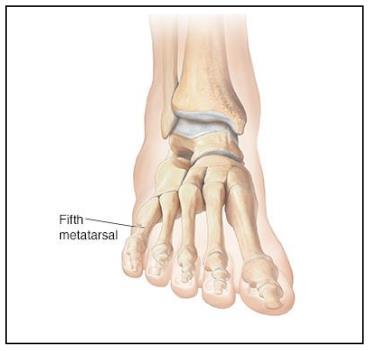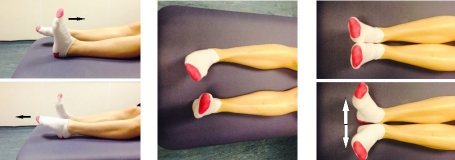Download and print as a PDF (279kB pdf)
On this page
- What is this information about?
- Why have I been given this information?
- What is a base of 5th metatarsal fracture?
- How long is it likely to take for my broken 5th metatarsal to heal?
- What can I do if I have pain and swelling?
- What should I do when I am walking?
- Will I get any further appointments, advice, or treatment (follow-up) after I have left A&E?
- What can I do to help the healing process?
- What should I do to reduce the chance that I may get a blood clot after I have broken my 5th metatarsal bone?
- What exercises should I start to do as soon as possible after I have been treated for my fracture?
- Frequently asked questions:
- Where can I find further information or advice if I need it after I have read this information?
What is this information about?
This information is about how you can help your 5th metatarsal fracture (broken 5th metatarsal bone) to heal. It tells you what you should and should not do if you have a broken 5th metatarsal. It includes advice on:
- how to deal with pain and swelling
- what to do about walking
- how you can help your fracture to heal
- what exercises you should do
Why have I been given this information?
You have been given this information because you have been diagnosed in A&E as having a broken 5th metatarsal bone. You will be referred to the Virtual Fracture Clinic (VFC). Before you start having care from the VFC following the advice in this information will:
- help your fracture to heal
- avoid further damage
- keep you as comfortable as possible while your fracture is healing.
What is a base of 5th metatarsal fracture?
This is when your 5th metatarsal bone is broken.
The 5th metatarsal is the long bone on the outside of your foot, as shown in the below image:

How long is it likely to take for my broken 5th metatarsal to heal?
It is likely to take around six weeks for your broken 5th metatarsal to heal. You may still have some pain and swelling in your foot for about three months (12 weeks).
If you are putting strain on your foot by, for example, doing heavy tasks or going for long walks you may still get some mild discomfort and swelling for around three months after your injury happened.
What can I do if I have pain and swelling?
- take your usual painkiller. Follow the dosing advice on the packet.
- swelling is often worse at the end of the day. Elevating your foot (sitting or lying with your foot raised up) can reduce the swelling. Raise your ankle above the level of your hips. You can use pillows or a stool to keep your foot up.
- use cold packs.
- a cold pack (ice or gel pack or frozen peas wrapped in a damp towel) can provide short term pain relief.
- put the pack on the sore area for up to 15 minutes, every few hours.
- be aware, make sure the ice is never in direct contact with the skin. Check your skin regularly. If your skin goes purple or white or blisters or if your pain increases do remove the pack straight away. This may be difficult to see on black or brown skin.
What should I do when I am walking?
Do wear comfortable footwear. You may walk on the foot as much as is comfortable.
Be aware
We may have given you a special boot or shoe to wear while your fracture is healing. This will help to keep you comfortable, but it does not change how quickly or how well your fracture heals.
Will I get any further appointments, advice, or treatment (follow-up) after I have left A&E?
You have been referred to the Virtual Fracture Clinic (VFC). The VFC will contact you about follow-up appointments where they will check how you are. They will give you any further treatment or advice that you need. The VFC will help you manage your injury until it is healed.
What can I do to help the healing process?
- Do rest and elevate your foot. This allows the early stage of healing to begin. Raise your ankle above the level of your hips to reduce swelling.
- Stop smoking. Smoking will slow down your healing and can even stop it altogether. If you would like help with stopping smoking talk to your GP or visit www.smokefree.nhs.uk for further information.
- Put weight through your injured foot (use your foot to bear your weight).
- Try to walk as normally as possible.
- Do the exercises described in this information.
What should I do to reduce the chance that I may get a blood clot after I have broken my 5th metatarsal bone?
To increase your blood circulation and help to reduce the chance of getting a blood clot do move your foot and ankle around as much as you can by doing the exercises below.
You can find further information about how to reduce the chance that you may get a blood clot in our leaflet – Reducing the risk of blood clots with lower limb immobilisation.
What exercises should I start to do as soon as possible after I have been treated for my fracture?
Do these ankle and foot exercises three to four times a day.
Each time you do them repeat each exercise 10 times.
1. Point your foot up and down within a comfortable range of movement.
2. Make circles with your foot in one direction and then change direction.
3. With your heels together, move your toes apart, as shown in the picture.

Doing these exercises will help you to be able to move your foot and ankle as much as you need to. They are called range of motion exercises.
Frequently asked questions:
When should I stop using the special shoe or boot that you have given me?
As soon as you feel comfortable. This is often after two to four weeks.
Can I wear my own shoes?
Yes, if this is more comfortable.
When can I drive?
You may drive again once you feel you can safely deal with all emergency situations without hesitation. For example, you must be able to stop the car quickly and in full control and safely avoid obstacles.
You cannot drive when you are wearing either the ‘rigid sole shoe’ or the ‘boot’.
When can I return to work?
It depends on your job. You should reduce the amount of lifting or loading and walking for the first four to six weeks.
You may need to adjust what you do at work if you normally:
- wear safety shoes
- walk long distances
- climb ladders
Where can I find further information or advice if I need it after I have read this information?
Please use the NHS Website www.nhs.uk for general medical information. You can contact the NHS 111 online (111.nhs.uk) or phone (phone: 111) service for information and advice on how to get treatment if you think you may need it.
You can also contact your GP surgery.
There is a walk-in Minor Injuries Unit at Bognor War Memorial Hospital which can help with minor to moderate illnesses and injuries. If you are not sure whether your condition can be treated at the Minor Injuries Unit, please phone 01243 623 563 first to check.
This information is intended for patients receiving care in Worthing and Chichester St.Richard’s hospital.
The information here is for guidance purposes only and is in no way intended to replace professional clinical advice by a qualified practitioner.